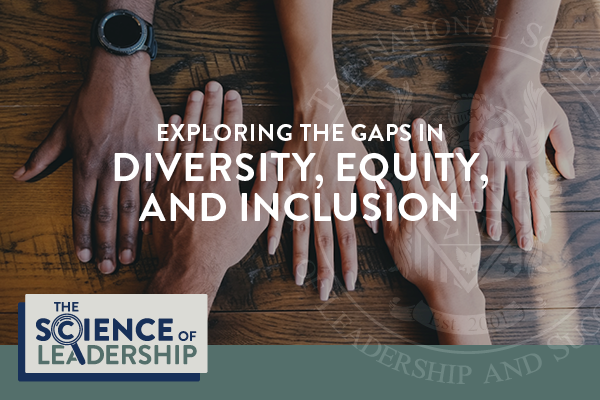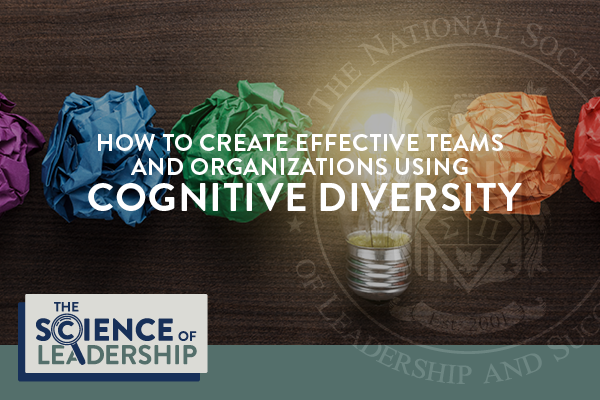Many companies claim that diversity, equity, and inclusion (DEI) initiatives are one of the most important factors for their business, but according to the SmartRecruiters “State of Diversity Hiring Report 2021,” 51 percent of organizations lack even a basic DEI plan.
The report also suggests that many companies are missing other baseline DEI initiatives, such as diverse public-facing branding, structured interviewing processes, and funding to meet DEI goals.
This week in The Science of Leadership, we dig into the SmartRecruiters report to better understand these shortcomings and explore what steps companies can take to build a DEI program that genuinely moves the needle.
The Study: A Small Snapshot of DEI
To shine a light on the state of diversity, SmartRecruiter used data collected from those who’ve taken their Diversity Hiring Toolkit assessment. It provides companies with an objective evaluation of their current DEI programs and allows them to create a blueprint to address any gaps.
For the report, the team analyzed responses from 401 companies to draw their conclusions with 53 percent of respondents from North America, 39 percent from Europe, the Middle East, and Africa, and 8 percent from Asia-Pacific.
The responses were analyzed using the team’s Diversity Hiring Maturity Model. This model “evaluates your hiring capabilities across all 12 standards (and four success pillars) using the Diversity Hiring Maturity Model. This rubric assigns a score corresponding to the level of sophistication and rigor the organization has invested, starting with Level 1 (Diversity Talent Aware) to Level 4 (Diversity Talent Ally).”
It’s important to note that the team is drawing a broad conclusion based on a relatively small sample size. Hopefully, as DEI comes under more academic scrutiny, more studies will offer greater insight. That being said, the team’s findings and analysis still produced interesting takeaways for organizations and leaders to consider.
Five Key Takeaways Impacting DEI
Once the numbers were crunched, the team broke their findings into five key takeaways that showcase the areas where DEI fell short in 2021.
1. Scratching the Surface: Diverse Branding
Many organizations fail to produce basic diverse branding. If a business wants to attract diverse talent, that talent needs to see themselves as a worker there. If a company’s website features only one group of people, it’s exclusionary.
“The first step to attracting diverse talent is to foster Diversity Brand Equity, or the ability to allow underrepresented candidates to see themselves working for you through various brand interactions,” the team said.
“And yet, many organizations are missing out on the most basic opportunities to share their commitment to building a diverse and inclusive workforce with potential applicants through these public-facing channels.”
The report found that only 15 percent of respondents featured underrepresented groups on their company websites, and this figure drops to 10 percent on career channels or on other recruiting collateral.
2. Working Without a DEI Plan at All
The most attention-grabbing finding is that over half of respondents had no defined diversity hiring plan at all, and 29 percent reported that they have “some” plan. This is surprising because DEI programs are a hot topic for talent leaders and have been for years.
The team also found that North America and Europe are more likely than other areas to lack a proper, strategic plan.
“Companies in Europe and North America are less likely to have strategies and processes in place for setting diversity hiring goals than their peers in South/Latin America, Asia and Pacific, and Africa,” they report.
3. Diversity Programs Lack Fundings
Like all business initiatives, diversity programs require financial backing for success; however, 68 percent of respondents reported that their budget doesn’t align with their goals. This points to one of the biggest challenges facing DEI: a lack of commitment, which leads individuals to lose trust in organizations that are “all talk.”
“Candidates are tired of seeing companies make empty promises to improve diversity and inclusion,” Rocki Howard, DEI Executive, said in the SmartRecruiters report.
“By authorizing adequate funding for diversity hiring initiatives, company leaders signal their commitment to diversity with capital — a stronger and more meaningful action than public statements alone.”
4. Internal Talent Issues
Takeaways four and five dig into how a lack of DEI initiatives impacts talent acquisition and mobility. First, the team looked into how well organizations provide opportunities to internal workers. 82 percent of respondents do not have a process to make open roles available to all employees.
Despite this figure, the team reports that:
“Across industries, most participants said they make job postings available internally, and nearly three-quarters have a communication mechanism that makes internal candidates aware of job openings. But these passive methods may not reach your diverse talent.”
5. External Talent Issues
In their fifth and final takeaway, the team looked into external talent, specifically how bias creeps into hiring when organizations don’t have proper processes in place.
Only 18 percent of respondents reported that they have a structured interview process, and 69 percent said their companies do not have a method for presenting candidates to hiring managers in a way that reduces bias.
Without internal and external structures in place, companies are missing out on great talent to move up in an organization and have true equity, or onboarding diverse voices in the first place.

Diversity Starts with Commitment
Though the report highlights a lot of lows, the team concludes that there is a huge opportunity for many companies to start making an impact.
“For companies making a true commitment, our research reveals significant opportunities to move the needle. Unfortunately, these opportunities are often not being properly utilized or even ignored altogether. Most companies have made a commitment to improve, but many lack follow-through,” concludes the SmartRecruiters team.
We share that opinion at The National Society of Leadership and Success (NSLS) because creating a truly diverse and inclusive environment starts with strong leadership. After all, leaders have the power to influence and evolve their workplace cultures.
Follow-through, like the SmartRecruiters team mentioned, is of utmost importance. Diversity and inclusion initiatives must “walk the walk” if organizations want to create internal and external trust with the public, future hires, and current employees.
Those who create robust DEI plans can ensure underrepresented voices are empowered and heard, leading to many positive business outcomes, including higher levels of productivity and increased employee retention.
The Science of Leadership connects cutting-edge leadership research to the real world.
Ready to dig deeper? Read SmartRecruiter’s full report here and their Diversity Hiring Toolkit here.
Have a burning question about any of the topics we’ve covered? Email us at blog@nsls.org. We’d love to hear from you.




